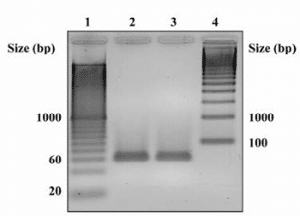Context
Research and financial efforts spent on biodefense technologies highlight the current concern for biothreat event preparedness. Nonhazardous but relevant “simulant” microorganisms are typically used to simplify technological developments, testing, and staff training. With this work, we investigated a new candidate, Cydia pomonella granulovirus (CpGV), for simulating large double-stranded DNA virus threat agents such as smallpox. CpGV belongs to the baculovirus family and is currently used as a pesticide. We developed an assay based on real-time PCR to provide a molecular tool to detect and quantify this model virus1).
[1] L. Garnier et al., Applied and environmentalmicrobiology, Mar. 2009, p. 1614–1620 Vol. 75, No. 6
Materials
- Precellys®24
- Precellys® kit: 03961-1-005 (glass beads 0.1 mm)
- Sample: occlusion bodies of CpGV named granules
- Buffer: 100 µl of a solution of yeast RNA 0.1mg/ml (to saturate the surface of glass beads)
- Centrifugal instrument
- Real-time PCR
Protocol
- Precellys®24: 6500 rpm, 45sec.
- Centrifugation: 4,000 rpm, 1 min.
- DNA purification.
- Analysis: Real-time PCR assays.
Results
We designed PCR primers and a probe for a specific gene that encodes a structural protein of CpGV. In a preliminary quantitative PCR (qPCR) assay, where no DNA standard was added, the success of this assay was assessed by checking with two different samples of CpGV DNA the presence of an amplicon with the expected size (59 bp) and showed in the figure 1. The specificity of our qPCR assay against a large panel of potential cross-reactive microorganisms was checked, and the suitability of the assay for environmental samples, especially aerosol studies, was determined. In conclusion, we suggest using Cydia pomonella granulovirus as a simulant of variola virus for biodefense technologies studies.
Figure 1: Agarose gel electrophoresis of amplicons produced by the qPCR assay. Lane 1, 20-bp ladder; lanes 2 and 3, PCR products from two different template CpGV DNA samples; lane 4, 100-bp ladder.


